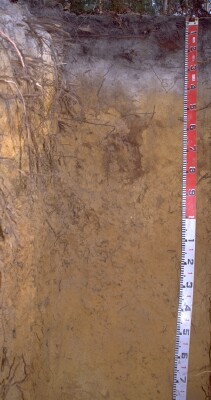CFTT18
| Site: Stradbroke | Location: APP species/seedlot trial VRV148 |
| Aust. Soil Class.: Melacic, Sesquic, Aeric PODOSOL | Great Soil Group: podsol |
| Tech. Class: 022-2-50/1-2-3-11 | General Landscape Description: Longitudinal dune with 2% slope to north. |
| Geology: Pleistocene aeolian sediments | APP Mapping Unit: Gormandale |
Soil Profile Morphology:
Surface Soil
| A1 | 0 – 25 cm | Very dark grey (10YR3/1) loamy sand; single grained; very weak consistence moist; clear and smooth transition to: |  Site CFTT18 Soil Profile |
| A2 | 25 – 40 cm | Light grey (10YR7/1) sand; single grained; loose dry; clear and smooth transition to: | |
| A3 | 40 – 70 cm | Brownish yellow (10YR6/6) sand; single grained; loose dry; smooth and wavy transition to: | |
| Subsoil | |||
| Bs | 70 – 140 cm | Reddish brown (5YR4/4), with many, very coarse, distinct, yellowish red (5YR5/6) and brownish yellow (10YR6/6) mottles; sand; single grained; loose moderately moist; very many ferruginous nodules (less than 60 mm); diffuse smooth transition to: | |
| C | 140 – 190 cm | Reddish yellow (7.5YR6/8) sand; single grained; loose, moderately moist. | |
Management Considerations:
- Plant Available Water Capacity (PAWC) is low for sandy soils such as these. The soils are, however, well drained.
- These strongly acidic sandy soils have a very low nutrient holding capacity and are considered infertile – being naturally deficient in nitrogen, phosphorus, sulphur and potassium. Nitrate and sulphate are readily removed by leaching. Deficiencies of trace elements such as copper, zinc and molybdenum are likely to occur. The trace element boron (B) leaches rapidly through acid sandy soils and deficiencies are also likely to occur.
- Roughly fits into Gormandale, but has a coloured A3; no coffee rock but iron cemented sand concretions. No samples taken.


